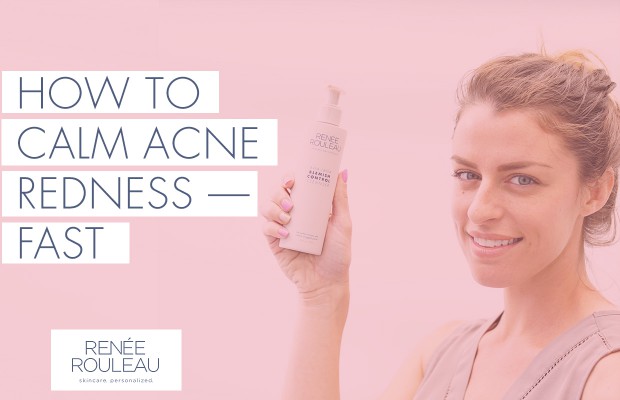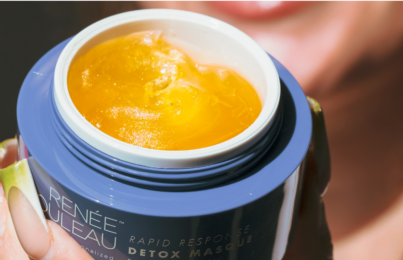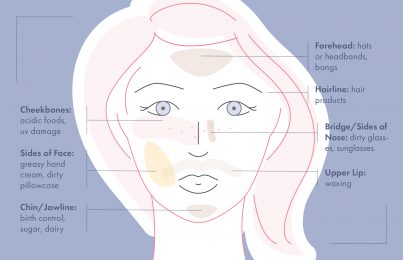A big concern for those who get frequent pimples is how to reduce redness from acne, also known as post-inflammatory erythema (PIE). Acne is an inflammatory disease of the skin, so reducing the look of inflammation can be a helpful way to make breakouts appear less noticeable. To top it off, irritation from using harsh products and acne prescriptions is all too common (and will actually make redness worse).
In this post, I’ll share five of my favorite ingredients you can use to get rid of redness from acne and give your skin a clearer, calmer look.
How Does Acne Cause Redness?
Let’s begin by talking about how and why the skin gets red when acne is present.
Infection
Whenever you have an angry, red blemish, this indicates that there is an infection with bacteria present. To combat this, your body initiates a healing response by sending white blood cells to the site. As these white blood cells flood the capillaries surrounding the blemish, the capillaries expand leading to visible redness and swelling.
Post-Inflammatory Erythema (PIE)
Depending on the type of blemish, the capillaries surrounding a blemish can become dilated to the point where they actually burst and bleed. This leaves behind vascular damage in the form of post-inflammatory erythema (PIE).
PIE is the official term for those annoying red marks that can get left behind after your acne blemish finally dries up and is no longer active. This is more common in those with fair skin tones since their capillaries tend to be thinner and weaker, to begin with.
Reducing Irritation from Acne Redness
As if infection and PIE weren’t enough, many ingredients used to treat acne can unfortunately also be quite harsh and drying. This causes skin irritation, which translates to redness.
Irritation from harsh acne products can make acne appear worse and also makes the skin more susceptible to developing further blemishes. The best way to prevent this is to use an oil-free moisturizer to keep the skin hydrated and healthy without clogging pores.
Harsh products can also cause dryness, which can be accompanied by redness. Here’s how I fixed my nephew’s dry, red skin, in case you are experiencing dry, flaky skin like he was.
Best Ingredients to Reduce Acne Redness
Now that you know how acne causes redness in the skin, here are five ingredients to look for that will help get rid of redness.
1. Green Tea
What it does: A plant-based antioxidant known for its soothing, anti-inflammatory benefits to calm signs of redness. Green Tea is rich in catechins and proanthocyanidins, which are found to be effective against Reactive Oxygen Species, a damaging free radical. While there are other types of teas, such as white and red, green tea is best for reducing redness from acne.
Side effects: None.
2. Lichocalchone (Chinese Licorice)
What it does: It disrupts the skin’s biochemical cascade that leads to the skin getting red and uncomfortable.
Bright yellow in color, this molecule also lessens what is known as lipase, an anti-lipid enzyme produced by acne bacteria both on the skin’s surface and within the pores. Scientists have linked lipase to the redness and visible inflammation seen in those with moderate and severe acne cases.
Lichocalchone provides immediate relief to cool redness while decreasing puffiness and tenderness from painful blemishes. When you use it regularly, the weakened components of the skin from blemishes that lead to chronic redness are strengthened.
Side effects: None.
3. Red Marine Algae
What it does: In nature, all types of algae are constantly being exposed to extreme conditions. Over time, these plants have developed defense systems against the elements that can be beneficial when applied to human skin. Unlike plants on land, algae do not have roots. Instead, they absorb all essential minerals and trace elements directly from the seawater into their cells.
While there are over one hundred types of algae, the one that I find incredibly effective for making the skin look less red from acne is red marine algae.
This ingredient has long been considered to have “healing” capabilities for all types of stressed skin conditions due to the abundance of vitamins and minerals. When used regularly, it can also act as an immune system enhancer to help prevent visible breakouts from occurring in the first place. (An ingredient with the word “red” in it that helps the skin look less red, imagine that!)
Side effects: None.
4. Salicylic Acid
What it does: It’s an exfoliating acid that helps soften and shed the horny outer layers of the skin. Salicylic acid is a beta-hydroxy acid (BHA) famous for its calming antibacterial properties that help prevent and clear blemishes. This ingredient is considered to be anti-inflammatory, so it’s beneficial for reducing the overall redness in the skin from acne.
Additionally, since salicylic acid is an exfoliant, it will break down scarred cells leftover from blemish marks. This will help PIH (post-inflammatory hyperpigmentation) to go away faster.
Salicylic acid is also one of the most effective ingredients for the prevention of clogged pores, blackheads, and closed comedones (non-infected bumps under the skin.) Anytime you can prevent acne from appearing in the first place, you’ll have significantly less redness to deal with.
If you want to reduce inflammation and redness from acne, this ingredient is a must. Just be sure it’s used in gentle formulas so as not to dry out the skin.
Side effects: None, as long as you are using it correctly. Using an acid too often or incorrectly can result in a damaged skin barrier and trigger inflammation and dryness. If you are pregnant, most doctors suggest avoiding salicylic acid during pregnancy.
5. Sea Whip Extract
What it does: A soothing, anti-inflammatory ingredient to help reduce all forms of redness in the skin and lower skin sensitivity. This is especially important if you’ve been using topical prescription medications that leave your skin dry and irritated.
Produced from an organism found in marine life, sea whip (also known as pseudopterogorgia elisabethae) inhibits the inflammatory enzyme phospholipase A2, which is responsible for skin irritation. With continued use, discomfort and surface tenderness are brought under control while soothing hydration is infused into the skin to repair the skin’s moisture barrier from harsh products.
Simply put, sea whip is very “healing” to reduce redness from acne and make the skin not look so angry.
Side effects: None.
While there are many other ingredients that do a great job to reduce redness from breakout scars and irritation, these are definitely my top five. This is why I have chosen them to use in many of my products.
Of course, the goal is to prevent breakouts from occurring in the first place so you would never have to deal with the redness.
Celebrity Esthetician & Skincare Expert
As an esthetician trained in cosmetic chemistry, Renée Rouleau has spent 35 years researching skin, educating her audience, and building an award-winning line of products. Her hands-on experience as an esthetician and trusted skin care expert has created a real-world solution — products that are formulated for nine different types of skin so your face will get exactly what it needs to look and feel its best. Trusted by celebrities, editors, bloggers, and skincare obsessives around the globe, her vast real-world knowledge and constant research are why Marie Claire calls her “the most passionate skin practitioner we know.”



